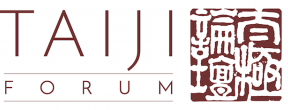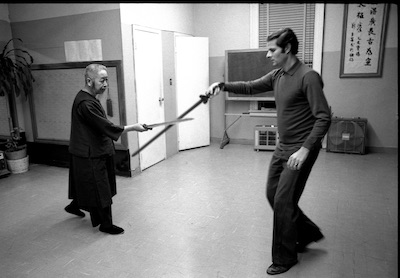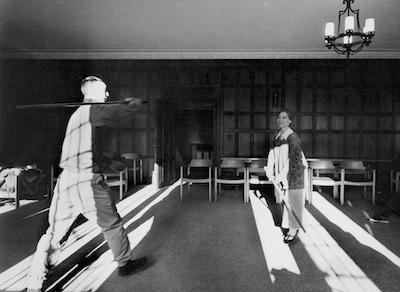CONCERNING THE CENTRE
In the Classics it is said that everything moves from the centre. The centre must stay quiet and subtle and the legs and arms move from it and around it. As we improve the centre becomes fine and stable and we become aligned, balanced and in harmony. If we lose our centre we become scattered and we lose integrity.
When doing sword form or fencing the sword is moved from our centre, and on the sword’s centre. Our centre remains relatively still as our arms and the sword move around it, and the sword’s centre stays relatively still as the blade and the pommel move around it. In other words, our sword’s centre stays mostly in front of our Dan Tien* as we move, rising and lowering and not by swinging our arms to the left and right, willy-nilly.
The Japanese Sword Classics use the idea “The Seat of the Sword” to refer to the Dan Tien as related to swordplay.
“ ‘Seeing with the body and limbs’ means trying not to allow our body and limbs to be disconnected from our opponent’s Seat of the Sword, we see with the mind so that we may see with our eyes, we see with our eyes so that we may make our hands and feet go for our opponent’s Seat of the Sword.”
MITSUYOSHI
“Both the positioning of your feet and the carriage of your body should not be disconnected from your Seat of the Sword.”
MITSUYOSHI
At the highest level, our blade will be relentlessly seeking the O’s centre. Initially this will be an intention and whether it works or not is relative to the O’s skill. At some point it will hopefully become a natural act, as with magnets seeking poles, or flowers turning towards the Sun.
*The centre is called “Dan Tien” in Chinese, “Hara” in Japanese. The Dan Tien is also an organ named the “Greater Omentum” in western medical terms, it seems not to have any specific role, but it grows larger in some athletes as well as in advanced practitioners of the internal arts such as Yoga, Tai Chi, Bagua, Dervish spinning, etc.
Author and Images: Ken van Sickle
German version on our sister site!
- ON BEING A MASTER – Tai Chi Sword 53
- STRANGERS – Tai Chi Sword 52
- PADDED SWORDS – Tai Chi Sword 51
- SAFETY – Tai Chi Sword 50
- PARALLELS – Tai Chi Sword 49
- Swordsmanship – SEVEN QUOTES – Tai Chi Sword 48
- TI FENG & FA JING – Tai Chi Sword 47
- SUPPOSITIONS – Tai Chi Sword 46
- LAO TZU (Laozi) QUOTES – Tai Chi Sword 45
- ETIQUETTE – Tai Chi Sword 44
- FENCING PROCESS – Tai Chi Sword 43
- STRATEGIES – Tai Chi Sword 42
- TASSELS IN THE WIND – Tai Chi Sword 41
- SHOOT FLYING GOOSE – Tai Chi Sword 40
- RHINOCEROS GAZES AT MOON – Tai Chi Sword 39
- THE MASTER SITS BACK – Tai Chi Sword 38
- FIVE APPLICATIONS – 1. BLOCK AND SWEEP – Tai Chi Sword 37
- RULES OF ENGAGEMENT – Tai Chi Sword 36
- CONSIDER – Tai Chi Sword 35
- INVITATIONS – Tai Chi Sword 34
- THE TASSEL – Tai Chi Sword 33
- THE SWORD FINGERS – Tai Chi Sword 32
- Cheng Man Ching Photographs
- THE JOINTS – Tai Chi Sword 31
- THE GRIP – Tai Chi Sword 30
- SWORD MOVEMENT – Tai Chi Sword 29
- ON ALIGNMENT – Tai Chi Sword 28
- CONCERNING THE CENTRE – Tai Chi Sword 27
- EQUATIONS – Tai Chi Sword 26
- HSIN AND CHI – Tai Chi Sword 25
- On studying – NINE QUOTES – Tai Chi Sword 24
- THE SWORD MAIDENS – Tai Chi Sword 23
- THE SWORD AND CALLIGRAPHY – Tai Chi Sword 22
- Returning – MORE THOUGHTS – Tai Chi Sword 21
- Levels of TAI CHI SWORD – Tai Chi Sword 20
- FENCING – Tai Chi Sword 19
- Transcendence – Tai Chi Sword 18
- TURNING TRICKS – Tai Chi Sword 17
- Names of CHENG MAN CH’ING’S TAI CHI SWORD – Tai Chi Sword 16
- FORCE – Tai Chi Sword 15
- DIFFERENCES – Tai Chi Sword 14
- BEGINNERS’ MISTAKES – Tai Chi Sword 13
- MIND SETS – Tai Chi Sword 12
- SENSITIVITY – Tai Chi Sword 11
- HARMONY – Tai Chi Sword 10
- TIME AND HUMOUR – Tai Chi Sword 9
- WHY AND HOW – Tai Chi Sword 8
- SWORD DIMENSIONS – Tai Chi Sword 7
- A ROYALTY OF ARMS – Tai Chi Sword 6
- KENNETH VAN SICKLE – Tai Chi Sword 4
- CHENG MAN CH’ING – Tai Chi Sword 5
- PREFACE – Tai Chi Sword 3
- Introductory Thoughts – Tai Chi Sword 2
- EDITOR’S PREFACE -Tai Chi Sword 1
- Tai Chi Sword by Kenneth van Sickle
- Taiji Forum Qigong Weeks
 Join us for a trip into the fascinating world of Qigong!
Join us for a trip into the fascinating world of Qigong! - Taiji Forum Teemill Shop – Announcement
 Our Taiji Forum Shirt Shop is on the way – and growing!
Our Taiji Forum Shirt Shop is on the way – and growing! - Review on the International Push Hands Meeting 2024
 I am so glad I did, and wish I had done it before
I am so glad I did, and wish I had done it before - TuiShou is not fighting. So what is it then?
 In our view, tuishou is an exercise method which develops the tai chi qualities for martial use.
In our view, tuishou is an exercise method which develops the tai chi qualities for martial use. - Basic peng-lü drill push hands workshop
 you’ll learn a basic drill to explore the two fundamental jins (“powers”)
you’ll learn a basic drill to explore the two fundamental jins (“powers”) - The spiritual force of Yi in Push Hands
 our energy follows our attention/focus. –
our energy follows our attention/focus. – - Pushhands Patterns
 Ronja (Jantje) Hinze
Ronja (Jantje) Hinze - Music For Taijiquan Practice & Demonstration
 Music in the soul can be heard in the universe.
Music in the soul can be heard in the universe. - Push Hands Meeting 2024 beginners’ program
 The teachers and themes are published and the registration of Push Hands Meeting 2024 is ready!
The teachers and themes are published and the registration of Push Hands Meeting 2024 is ready! - Always move “just enough” (passive stepping)
 …not easy to practice, as our natural fear and caution, and sometimes our egos…
…not easy to practice, as our natural fear and caution, and sometimes our egos… - Tai Chi Push Hands Workshop Brescia
 meaning of some main Tai Chi principles in practice
meaning of some main Tai Chi principles in practice - Tai Chi stepping 9/10 – Always leave the line of attack
 The full leg provides the axis (and center point) for a circular movement
The full leg provides the axis (and center point) for a circular movement - Tai Chi stepping 8/10 – Match your steps
 Match your steps / Watch your timing
Match your steps / Watch your timing - Tai Chi stepping 7/10
 Choose your direction freely! (Active stepping)
Choose your direction freely! (Active stepping) - Tai Chi stepping 6/10
 Long steps mean lower stance
Long steps mean lower stance



















